A Little History:
Mound, Minnesota settled in 1853 as Mound City, is a town in the midst of
many lakes and bays. It is west of Minneapolis and flanked by the
western bays of Lake Minnetonka. Minne meaning "water" and Tonka meaning
"Great" in the Sioux language. This was the source of the name adopted by
Tonka Toys. (See aerial photo below).
Minnesota Nomenclature:
Minneapolis = city on the water ( Mississippi)
Minnesota = sky colored water
Minnehaha = laughing water
Minnetonka = Great water
I have been to several Tonka Toy sites and have seen the same account of
Tonka's beginning. They all talk about the little school house and the 3
founders of Mound Metalcraft.
I am convinced that while World and National history has a way of being
remembered, local history is almost always lost unless someone writes or
records to preserve information of local interest. I have no desire to down
play the achievements of anyone, but I know that some very important players
have been relegated to a position far less than they deserve, and the name
of one seems to have faded into oblivion. I have never read a history of
Tonka Toys but I would like too if one has been written. All I know
about Tonka is what I learned by keeping my eyes and ears open as a kid while
growing up in the small agrarian town of Mound, Minnesota. Most of
my opinions about Tonka were formed at a very young age, and my memories
are based on the perceptions I had at the time, mainly between 7 and 12 years
of age. My parents like so many others owned a farm but had to work
at other jobs to supplement their income. In our small town Tonka was the
main employer during the 1950's and 60's. Tonka was part of almost everyone's
existence in some way or another.
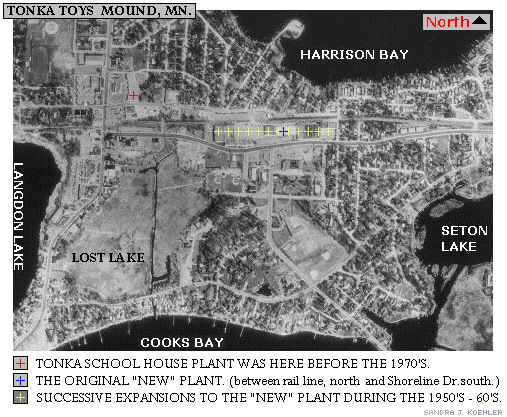
The above picture gives you an idea of how Mound is laid out in the midst
of several bodies of water. The main road 'Commerce' Boulevard runs north
and south on the left side of the picture. The main road coming from it and
heading east past the Tonka plant is now called "Shoreline Drive". In 1957
the locations marked by the red and blue crosses were all there was to Tonka.
The school house plant was a little more expansive than the red cross itself,
not very large. The plant shown by the blue cross was about two thirds of
what that section is today and looked like nothing more than a glorified
(large) quonset hut, aligned east and west. The yellow crossed sections were
just undeveloped land.
The old high school and businesses are adjacent to Commerce Boulevard and
Shoreline Drive . The remainder of what you see in the photo are mostly single
family homes. When I lived in Mound it was possible to "know of" just
about every family in the town and surrounding rural area, and in the 1930's
and 40's when Tonka Toys was born this was even more true.
Mound at that time had it's own 'Andy of Mayberry' kind of charm.
As a kid I spent innumerable hours playing with Tonka vehicles alone and
with my friends. I would often stand gaping at the Tonka's on the shelves
of the local hardware stores, especially at the mother of all Tonka's, ...
the Hook and Ladder Truck ... the ownership of which eludes me to this day.
I am not a historian nor am I an expert on Tonka's or the collecting of them.
If I am able to tell one year from another it is probably because
I grew up getting yelled at to "get out of the plant!". I spent many
hours in trash bins trying to determine what vehicle a given junk part had
been destined for. I spent vast numbers of hours with my face pressed to
windows and standing in doorways at the so called "Little Red Schoolhouse".
I was a kid of course and loved the process of manufacturing as much as I
loved the neat trucks.
I was able to learn things from a good source too. While most of the kids
I knew had relatives or family members, especially mothers (mine too) working
for Tonka, I was able to make contact with some real expertise in toy
manufacture. One man was amused by my interest in toy manufacturing and told
me some of his philosophy and other things about toy making.
 |
Russell L. Wenkstern. |
These are not Wenksterns words they are my paraphrasing of what he said to
me when I was about 10 years old, forty years ago.
1. Like the original developer of the Tonka Toy ... who I will get to, Wenkstern
also believed that most steel toys on the market were too expensive for the
average kid, so they made them "less" detailed in some ways and more
affordable as practical toys.
2. Toys should be educational and created with the child's development as
a primary goal.
3. Don't make toys that have no "real life" counter part. You want to satisfy
a demand not create a demand. Don't come out with some clever idea and
then try to sell it to kids. Like the hula hoop? I said. He laughed at that,
but I got the message that "a hula hoop" is rare in the dog eat dog
toy business.
4. Because car and truck models change every year (they did in the 1950's)
the toy vehicles should also change. When a new model truck comes out dad
buys it, and junior will want the keep up by getting the latest model from
Tonka as well. This strategy was great too. All you need do is change the
cab on the older vehicle designs. Wenkstern got personally involved in truck
cab redesign because he knew this would increase sales.
I had been told by adults at the time that the reason our real cars
and trucks were so expensive was because of annual retooling costs,
just for Detroit's "style" changes. When I rebutted him with
this, Wenkstern told me that changing the cabs will raise the number
of sales so much that the tools will wear out and need to be replaced anyway
so it would be pointless to not change them.
The basis of much Tonka collecting today is the changing designs instituted
after Wenkstern took over production in 1952.
5. You need really good people, not only skilled and capable, but dedicated
and proud of their part in a "great" achievement. Tonka's work force lived
up to it's name.
6. While people generally focus on big things it's often the little seemingly
insignificant things that have the most profound effect on your product's success.
Who was Russell Wenkstern?
He was not a legal founder of the original Mound Metalcraft but was one of
two people without which there would never have been a Tonka Toys as we knew
it. He was there on day one ... actually long before day one.
When young, Russell Wenkstern was also interested in machines and science.
He was fascinated by various manufacturing processes, and he loved toys.
As an adult this didn't change.
Born in Garber, Iowa Oct 1st 1912.
Grad. Teachers College Ellendale, N.D..
Taught math, science, industial arts, and coached sports.
Taught school in ND, OK, MI, and Mound, MN.
Wenkstern taught and coached at Mound High School, until he decided he needed
to make more money but also he wanted to get into some form of 'industrial
arts', rather than just teach it, and he was still fascinated by toys and
their manufacture.
In 1944 Wenkstern left Mound High and became employed down the street, (remember
Mound is a small town) at the "L. E. Streater " company, the big company
of Mound, Minnesota. Actually the toy business was E.C. Streater
Toys, after Edward C. Streater the son of L. E. Streater. Edward Streater
was placed in charge of Streater Industies (lumber retailing) in 1928. Edward
Streater wanted to manufacture products, especially toys. He built kitchen
cabinets and similar items and eventually store fixtures. The
main business became as it is today store fixtures, however many other products
have been produced over the years. When Wenkstern went to work for Steater
they were even producing ammunition boxes and other items for the war effort.
They were gaining an expertise in metal crafting with these war contracts
that E.C. Streater wanted to apply to a new line of toys after the war.

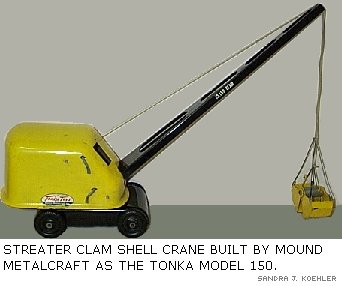
|
'Typical' of the type of vehicular
wooden toy Streater Toys built in Mound, Minnesota. This little wagon (black
paint faded from it's wheels) was filled with wooden blocks and many were
sold in the 1930's and 40's. There appears to be very few of these still
in existence probably due to the perishable nature of wooden toys versus
plastic or steel.
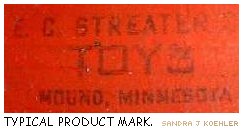
Toys were not the main business, but rather the passion of Edward C. Streater.
The toys end of the business had a very small work force. Edward Streater
himself probably designed this wagon as well as designed and built
the first toys and tooling which became the entire startup toy line of Mound
Metalcraft (Tonka Toys). |
The current L.E. Streater company has
reported recently before it's joining with L.A. Darling, that it has 650
employees. It's business operation is more than 20 fold what it was when
they went to Albert Lea, MN in 1957. In 1957 business was booming and
they had outgrown their plant. It's not accurate to interpolate
the number of employees based solely on size of operations but if you
did it, you would be in a ball park of about 33 employees at the
plant when it was "out grown" (although there probably were more than
that). When these toys were first made, and the concepts developed, many years before,
the entire Steater industries was much smaller, so what are we talking
about? Twenty? Fifteen?. When you consider the toy part of it which wasn't
the primary business there must have been very few employees involved,
probably half a dozen or less. That's why it is most plausible that Edward
C. with his love of toys, was the actual designer. It certainly was
not done by some distant coporate engineering department.
Edward Streater wanted to build pressed steel vehicular toys which were
affordable and practical for the average kid to play with. Few such toys
were currently available. The better metal toys of the day were far too detailed
and therefore expensive for the average parent to buy for play in a sand
pile. Streater was pursuing a compromise between detail and cost, for sales
to the common masses.
Originally E.C. Streater had plans for a complete line of little construction
vehicles. His new employee Wenkstern was very enthusiastic and immersed himself
into the study of the latest toy manufacturing technology.
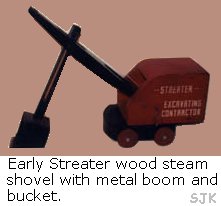 |
|
"Streater Excavating Contractor"
This toy steam shovel was one of the early hybrid wood and metal toys built
probably in the late 1930's or early 1940's. |
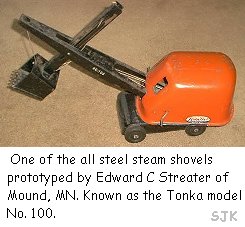 |
|
"All steel (not wheels)
steam shovels put into production by Edward C Streater under the
Streater name. These later became Mound Metalcraft's
Tonka model No. 100. |
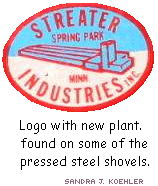 |
|
"Some of the pressed
steel steam shovels put into production by Edward C Streater under
the Streater name bore this decal indicating that these toys were
manufactured in what later became the J.R. Clark Rid-Jid plant.
If I'm wrong please let me know. |
When World War II ended, a vast number of corporations had to
convert their war production capabilities to peace time enterprise or go
under. Competition for many was fierce. Streater Industries needed to make
a decision as to it's concentration of resources, and direction in the
post war economy. They chose store fixtures over toys. As a result they remain
to this day one of the leaders in that field, and they abandoned toys.
Wenkstern felt the proto type toys were great as did Edward Streater.
If they didn't want these toys to be abandoned to sit on a shelf collecting
dust they would need to find someone with the appropriate technological
means to produce them.
In 1946 a small company known as Mound Metalcraft Incorporated of Minnesota
started production of gardening hand tools, in the basement of the "old"
Lynwood Boulevard red brick schoolhouse in Mound. The company was founded
by Lynn E. Baker, Alvin Tesch, and Avery Crounse. Mound Metalcraft was near
the largest four way intersection on the main street, and directly across
from the Mound High school where Wenkstern previously had taught, until 1944.
(I know little about these Metalcraft founders maybe you can give me some
insight or sources.) However I know that this was a working man's operation
and if you went there you would see these gentlemen, with sleeves rolled
up, actually working in the production of garden tools. These three men were
not wealthy venture capitalists as some people seem to believe.
In a small town like Mound was in the 1940's most people eat lunch and have
coffee at the same cafes and taverns. Everyone's kids go to school with everyone
else's kids, and everyone knows just about everyone else. Steater's
and Metalcraft's "paths" crossed very often especially at lunch time.
The job may have been to convince the operators (Baker,Tesch, and Crounse)
of little Mound Metalcraft with this "fledgling" business making garden tools,
that 1st they could actually produce these toys in large quantity without
going bankrupt in the process, and 2nd, despite the fact that people didn't
currently appear to be buying this type of toy ... they would! (fingers
crossed). If you don't have the resources to buy the prototypes and
tooling outright and aren't sure they'll sell, then take these to the
wholesalers toy show in New York and see what the response is ... may have
been the basic line. It is also possible that once Metalcraft knew of
the prototypes and tooling they may have been easy to sell on the idea and
had the surplus resources to procure them. (How good was the garden tool
business? They dropped it like a hot rock once they became involved with
Streater's Toys.)
In any case no one knew for sure what the response would be, with the wholesalers
in New York, and if it had been less than "great" the prototypes may
still be sitting on L E Streater's storage shelves. These were "great"
toys, and they needed to be manufactured. E.C Streater Toy Company
built the first toys that would be called "Tonka" (great) albeit as prototypes.
The limited production was under the name Streater Toys of Mound and Spring Park.
Wenkstern himself could have acquired these prototypes and created Tonka Toys Inc,
and he knew this, and later I believe he must have regretted not doing so.
Edward Streater knew he would not be able to manufacture his toys but felt
they needed to be built. This is why he sought out someone to produce the
toys rather than letting them sit on a shelf collecting dust. He wanted to
see his ideas and creations come to real form even if he couldn't do it himself.
In addition to the tooling and the prototypes available for the steam shovel
and clam shell crane, Mound Metalcraft certainly must have gotten Edward
Streaters drawings, concept plans and ideas for other toys, as well
as considerable advice as it would be inconsistant for Steater to withhold
any of these under the circumstances. Also this was a small town and these
people worked almost within sight of each other.
When I mention Streater to current residents of Mound they don't have
a clue what I am talking about. I remember a time in Mound when Streater
was a household word. This demonstrates the problem with "local" history,
and the volatility of it, a couple generations or less and it's gone forever.
Most amazing however is the glassy eyed look I get from Tonka collectors,
and self proclaimed Tonka experts. Some have heard of an L.E. Streeter store
fixture company in Minneapolis (which probably NEVER existed), but none ever
heard of an E.C. Streater Toy Company of Mound, MN. Ironicly without
this one man, not only would Tonka not be the company we knew it to be, it
wouldn't even have existed, and that is a "certainty". The founders of Mound
Metalcraft would have spent their years trying to make a living with rakes,
hoes and shovels and I mean spades not steam.
All the Tonka collectors would have "Never heard of Tonka Toys" most of their
spouses would be happier, or they would probably be collecting Nylints instead.
|







